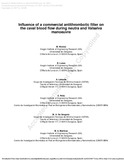Mostrar el registro sencillo del ítem
Influence of a commercial antithrombotic filter on the caval blood flow during neutra and valsalva maneuver
| dc.creator | Nicolás, M. | es_ES |
| dc.creator | Lucea, B. | es_ES |
| dc.creator | Laborda, A. | es_ES |
| dc.creator | Peña, Estefanía | es_ES |
| dc.creator | Malvè, Mauro | es_ES |
| dc.date.accessioned | 2020-10-15T11:31:35Z | |
| dc.date.available | 2020-10-15T11:31:35Z | |
| dc.date.issued | 2017 | |
| dc.identifier.issn | 1932-619X | |
| dc.identifier.uri | https://hdl.handle.net/2454/38411 | |
| dc.description.abstract | Anticoagulants are the treatment of choice for pulmonary embolism. When these fail or are contraindicated, vena cava filters are effective devices for preventing clots from the legs from migrating to the lung. Many uncertainties exist when a filter is inserted, especially during physiological activity such as normal breathing and the Valsalva maneuver. These activities are often connected with filter migration and vena cava damage due to the various related vein geometrical configurations. In this work, we analyzed the response of the vena cava during normal breathing and Valsalva maneuver, for a healthy vena cava and after insertion of a commercial Günther-Tulip® filter. Validated computational fluid dynamics (CFD) and patient specific data are used for analyzing blood flow inside the vena cava during these maneuvers. While during normal breathing, the vena cava flow can be considered almost stationary with a very low pressure gradient, during Valsalva the extravascular pressure compresses the vena cava resulting in a drastic reduction of the vein section, a global flow decrease through the cava but increasing the velocity magnitude. This change in the section is altered by the presence of the filter which forces the section of the vena cava before the renal veins to keep open. The effect of the presence of the filter is investigated during these maneuvers showing changes in wall shear stress and velocity patterns. | en |
| dc.description.sponsorship | This study was supported by the CIBER-BBN financed by the Instituto de Salud Carlos III, by the Spanish Ministry of Science and Technology through the Research Projects Nos. DPI-2010-20746-C03-01 and DPI-2013-44391-P and by the Spanish Ministry of Economy and Competitiveness through the Research Project No. DPI-2016-76630-C2-1-R. The experimental study was supported by the Instituto de Salud Carlos III, through the Research Project No. PI08/1424 and was performed by the Minimally Invasive Techniques Research Group (GITMI) of Aragon Government. | en |
| dc.format.extent | 13 p. | |
| dc.format.mimetype | application/pdf | en |
| dc.language.iso | eng | en |
| dc.publisher | ASME | en |
| dc.relation.ispartof | Journal of Medical Devices, 2017, 11(3): 031002 | en |
| dc.rights | © 2017 by ASME | en |
| dc.subject | Blood flow | en |
| dc.subject | Filters | en |
| dc.subject | Flow (Dynamics) | en |
| dc.subject | Pressure | en |
| dc.title | Influence of a commercial antithrombotic filter on the caval blood flow during neutra and valsalva maneuver | en |
| dc.type | info:eu-repo/semantics/article | en |
| dc.type | Artículo / Artikulua | es |
| dc.contributor.department | Ingeniería Mecánica, Energética y de Materiales | es_ES |
| dc.contributor.department | Mekanika, Energetika eta Materialen Ingeniaritza | eu |
| dc.rights.accessRights | info:eu-repo/semantics/openAccess | en |
| dc.rights.accessRights | Acceso abierto / Sarbide irekia | es |
| dc.identifier.doi | 10.1115/1.4035983 | |
| dc.relation.projectID | info:eu-repo/grantAgreement/MINECO//DPI2013-44391-P/ES/ | en |
| dc.relation.projectID | info:eu-repo/grantAgreement/ES/1PE/DPI2016-76630 | en |
| dc.relation.publisherversion | https://doi.org/10.1115/1.4035983 | |
| dc.type.version | info:eu-repo/semantics/acceptedVersion | en |
| dc.type.version | Versión aceptada / Onetsi den bertsioa | es |


